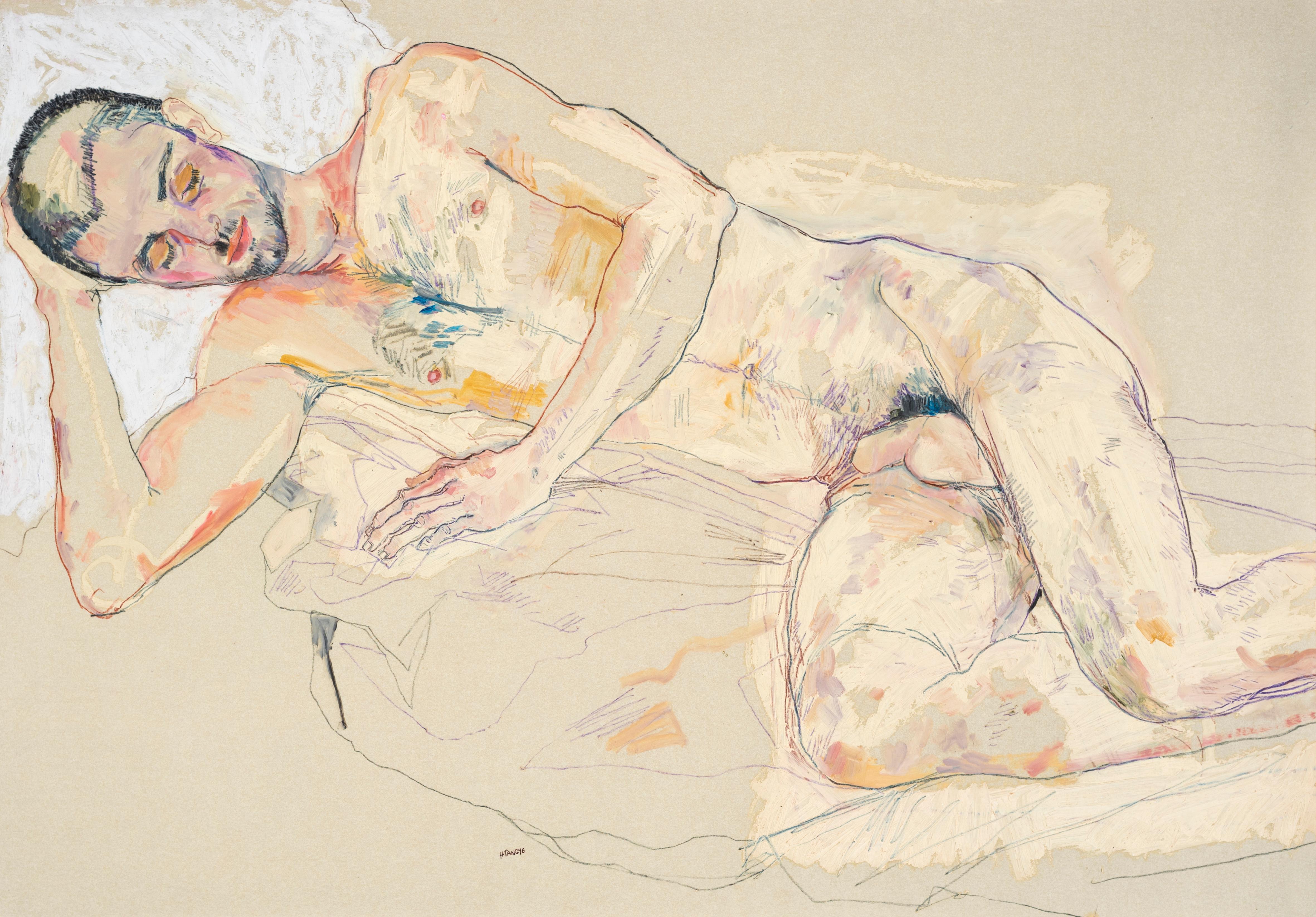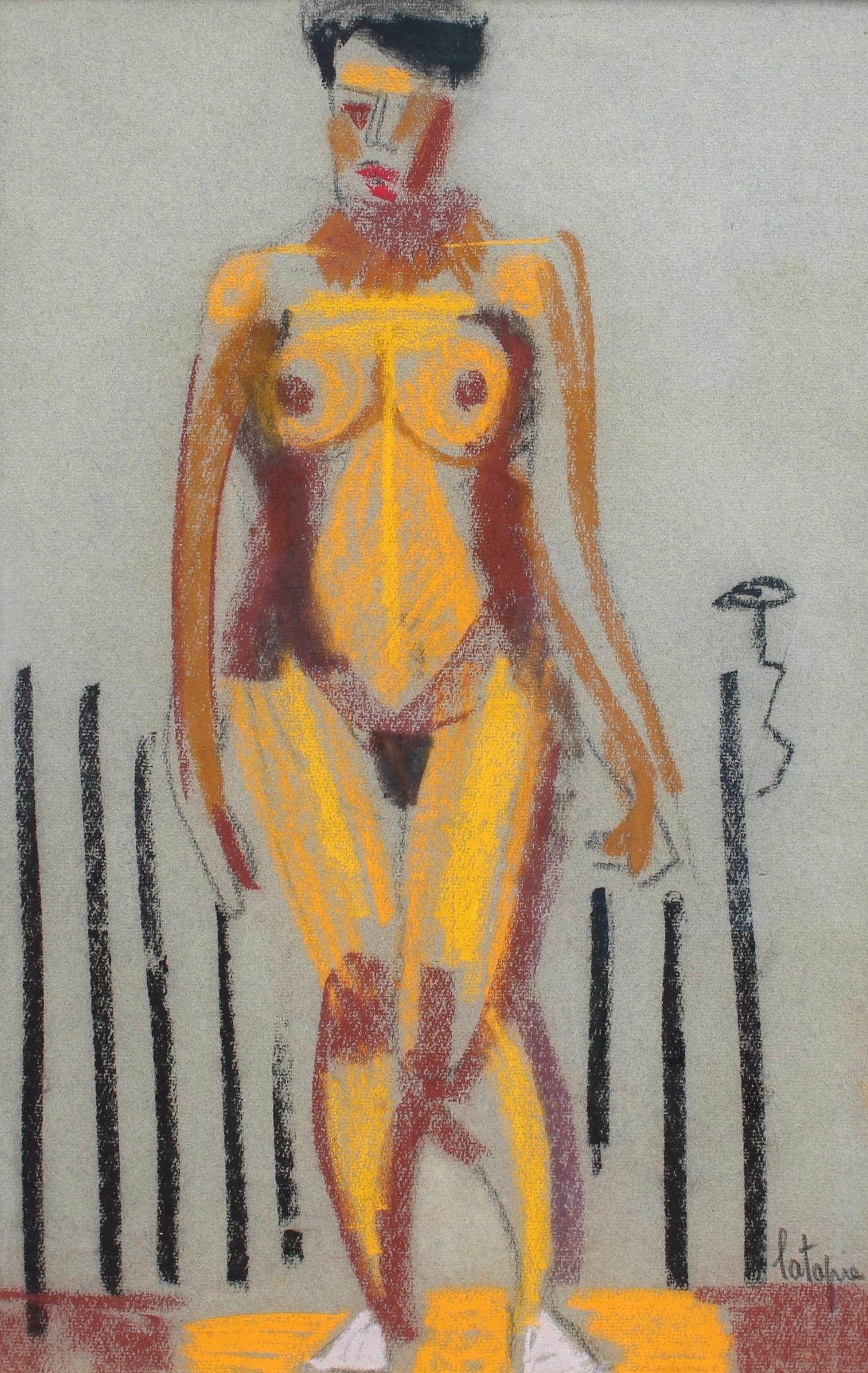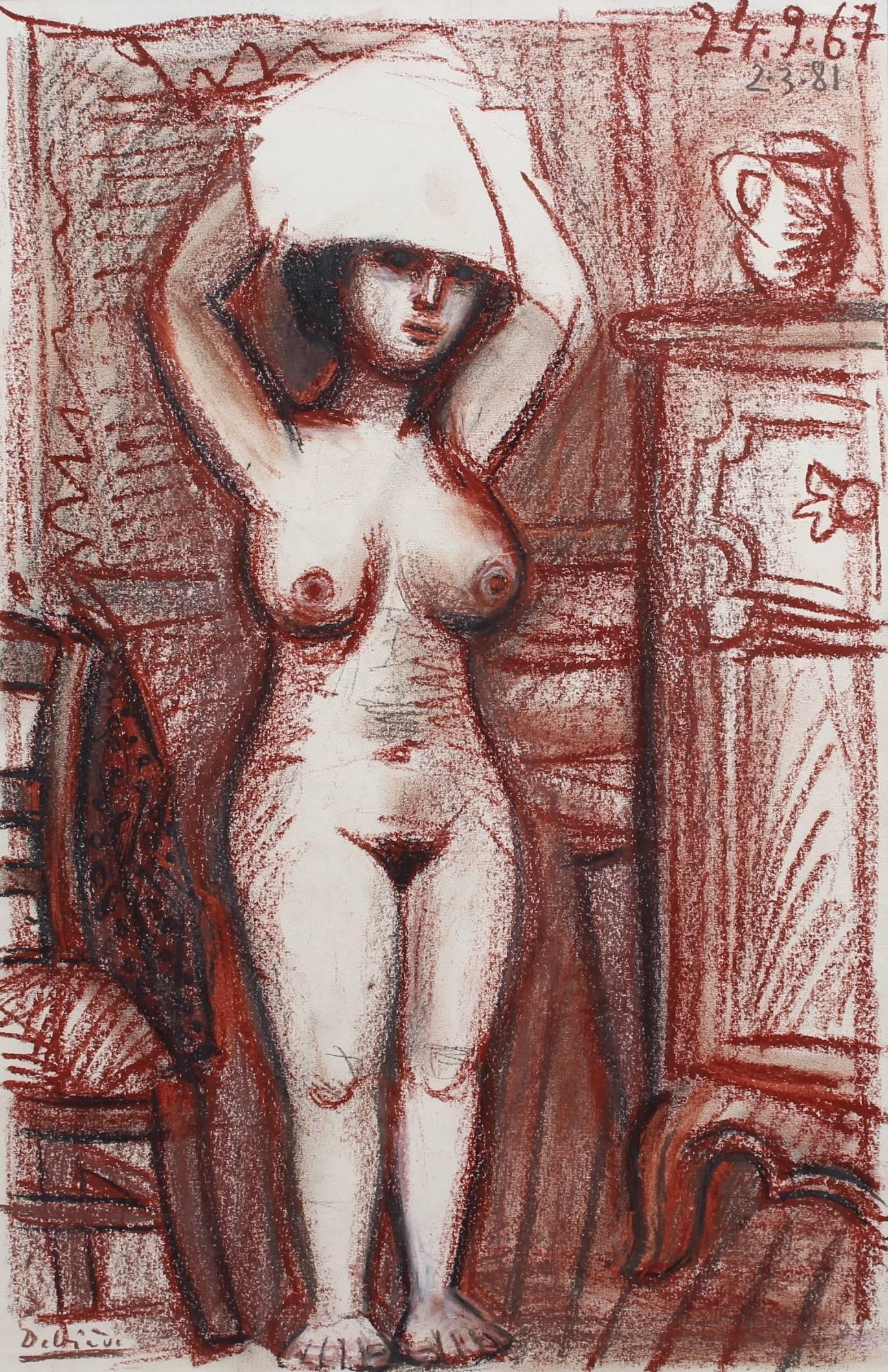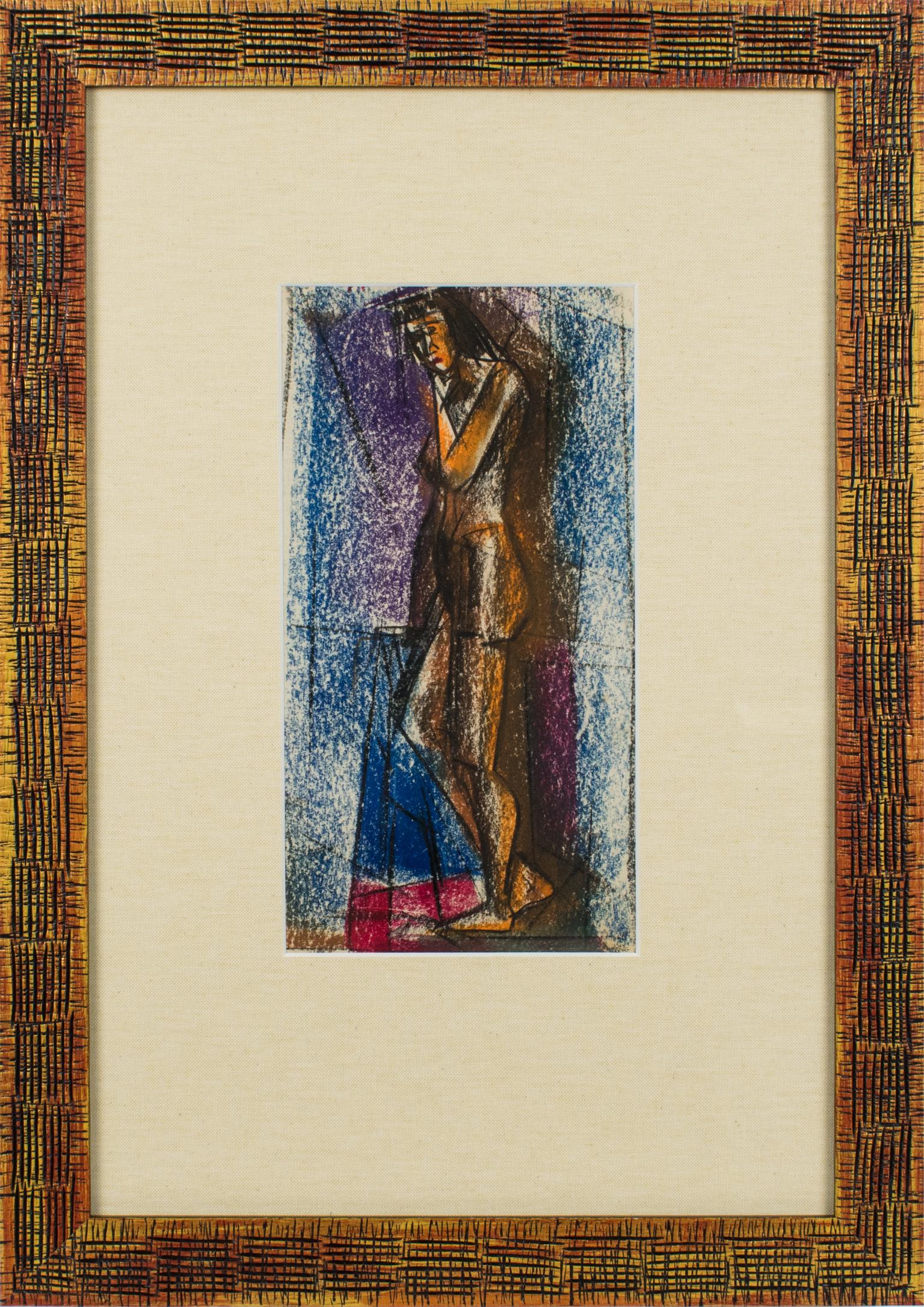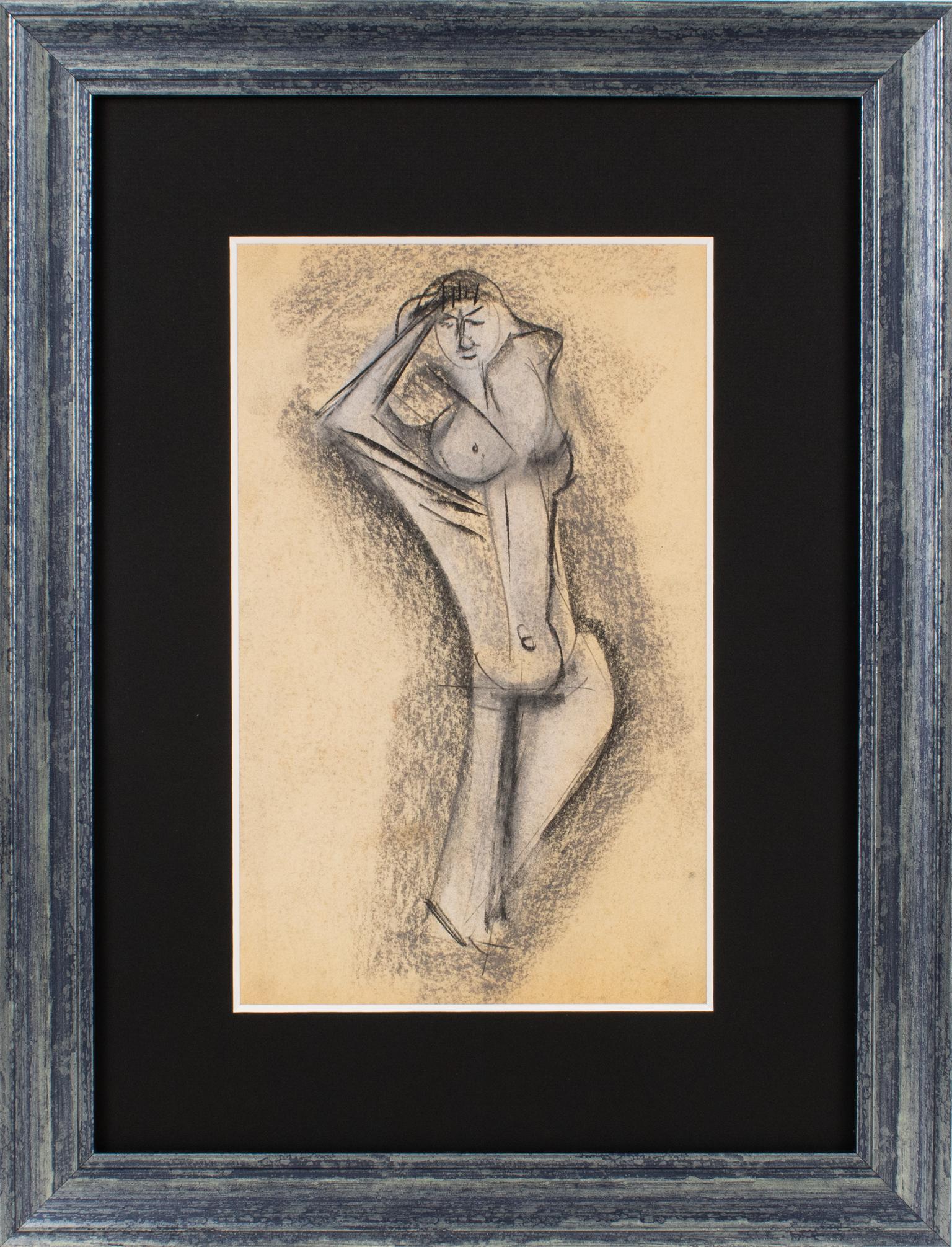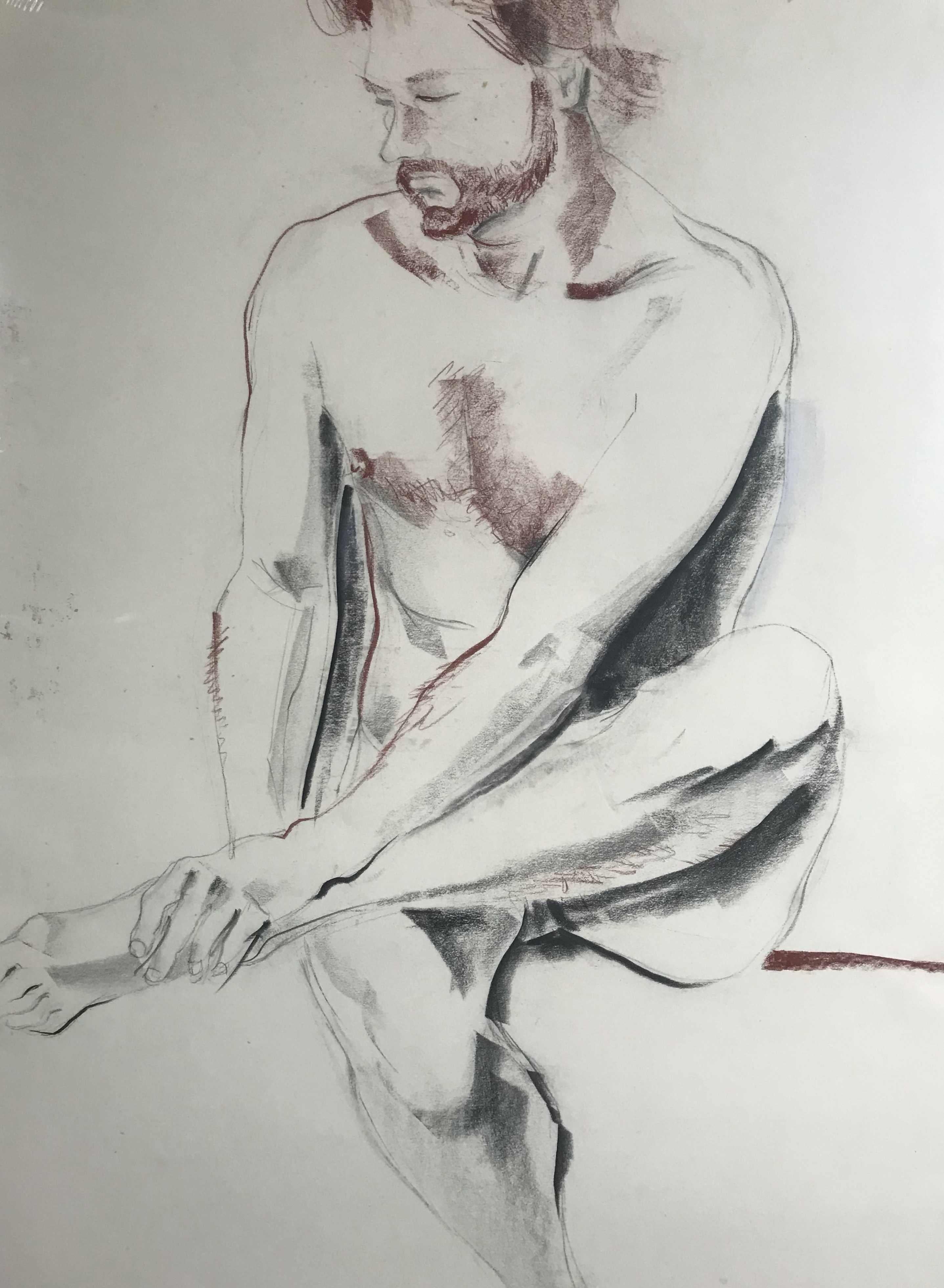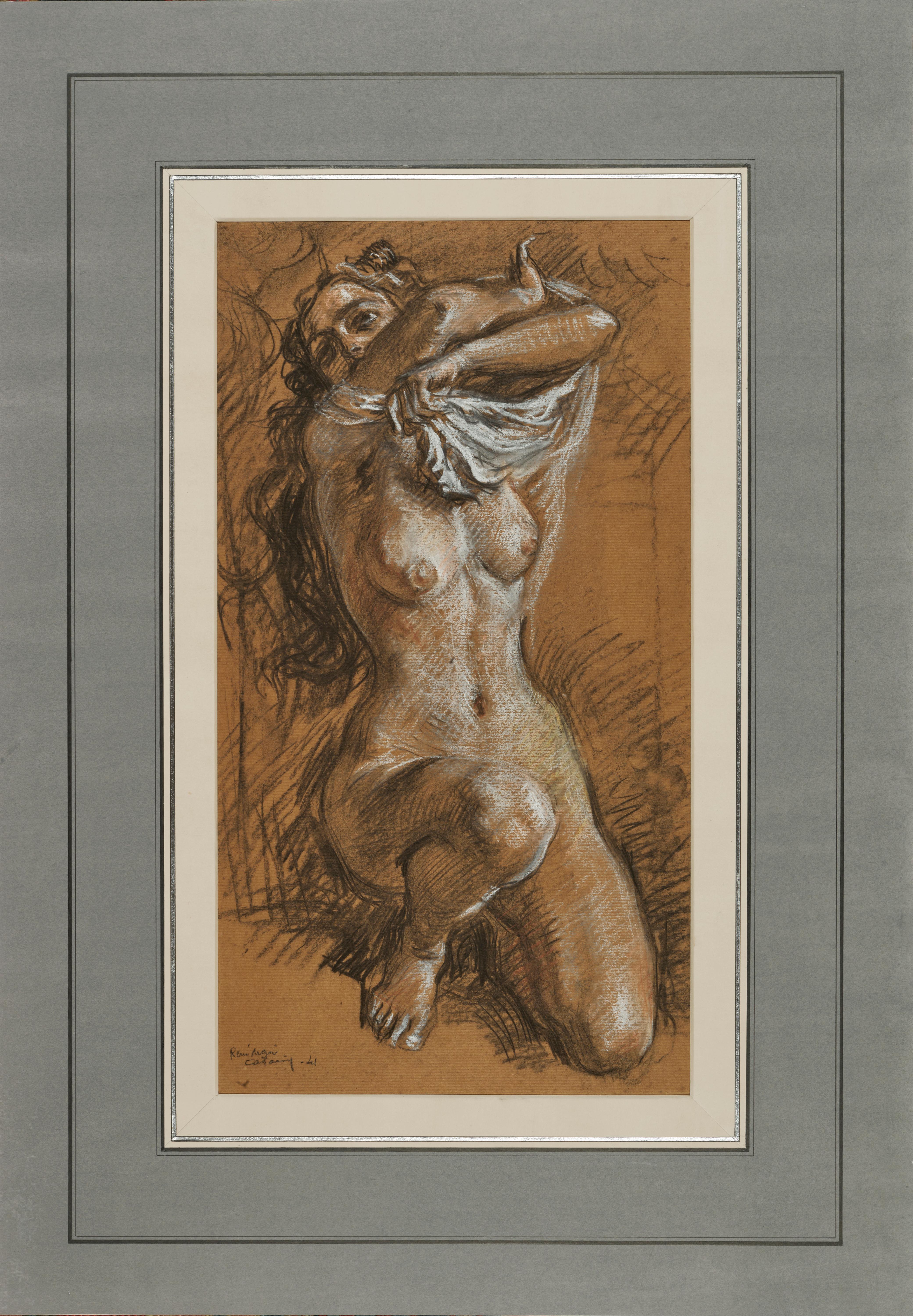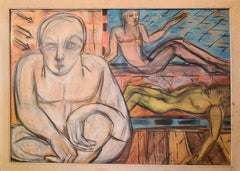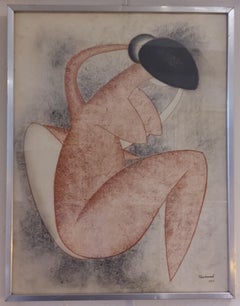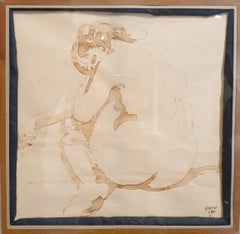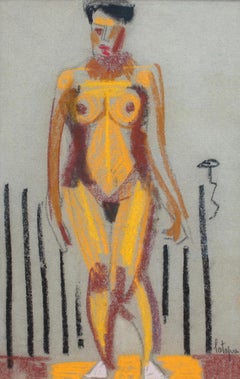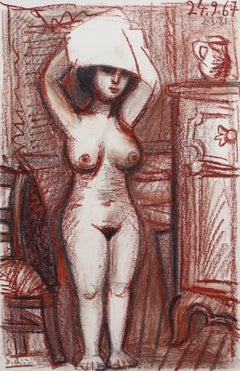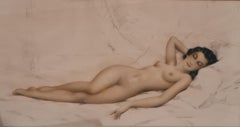
La Dormeuse, Large French Mid Century Female Nude
View Similar Items
Want more images or videos?
Request additional images or videos from the seller
1 of 11
LaunayLa Dormeuse, Large French Mid Century Female Nude1960s
1960s
About the Item
- Creator:Launay (French)
- Creation Year:1960s
- Dimensions:Height: 26.38 in (67 cm)Width: 42.92 in (109 cm)Depth: 1.19 in (3 cm)
- Medium:
- Movement & Style:
- Period:
- Condition:
- Gallery Location:Cotignac, FR
- Reference Number:Seller: LG/Launay1stDibs: LU1430212340912
About the Seller
5.0
Platinum Seller
These expertly vetted sellers are 1stDibs' most experienced sellers and are rated highest by our customers.
Established in 2000
1stDibs seller since 2020
165 sales on 1stDibs
Typical response time: 1 hour
More From This SellerView All
- Futurist, Novecento Italiano, Mid Century Italian Painting, Figures at the BathsBy Anselmo BucciLocated in Cotignac, FRMid 20th Century Italian Futurist, Novecento Italiano, work on paper, signed bottom right and with dedication top right (see photos). The subject is bathers enjoying the delights of a spa and sauna with colourful tiling to the background. The classical figures languorously positioned in repose but the central 'white' figure in stark contrast. The play on colours gives the work a vibrancy. The drawing is possibly a preparatory sketch for a larger work or mural. A vibrant, exciting and colourful work incorporating the styles of Futurism and the Novecento Italiano movement and with the influences or artists such as Anselmo Bucci, Adami, Jean Helion, Maryan, Achille Funi and Ugo Guidi. Anselmo Bucci was born in 1887 in Fossombrone in the district of Pesaro. Even though he studied Classics, right from a tender age he showed a talent for drawing and, when his parents moved near to Florence, he was taught by the artist Francesco Salvini. In 1904 the family settled in Monza and so the boy was able to study for a year at the Accademia di Belle Arti di Brera, but he did not follow up this educational experience and in 1906 he left Italy for Paris where he came into contact with the Parisian avant-garde, met fellow Italian artists such as Severini and Modigliani, and made friends with Picasso, Utrillo and Apollinaire. In 1907 he showed a painting at the Salon, but these Parisian years were most important for his love of engraving techniques – etching and dry point that enabled him to fully develop his themes characterised by movement. On the outbreak of war in 1915 he returned to Italy and he enlisted in the same battalion as several Futurist artists such as Martinetti, Boccioni, Sant’Elia and Carlo Erba. In 1914 he won the silver medal at the Mostra dell’Incisione (Exhibition of Engravings) at Florence. In 1917 in Paris he published pictures of war scenes entitled “Croquis du Front Italien”. In 1919 he printed twelve lithographs entitled “Finis Austriae” again showing events from the war. At the end of the war he lived between Milan and Paris and he dedicated his time completely to his art with personal exhibitions, exhibiting at all the most important Italian and French shows, in Belgium, Holland and England. In 1922, he established the group “Movimento del Novecento”, (Novecento Italiano), (20th century Movement) a joint venture with the artists Sironi, Funi, Oppi, Malerba, Dudreville and Marussig. Their aim was to return to figurative art in contrast with the growing extremism of the Avant-gardists. In 1925 he worked on the illustration of the first edition of Kipling’s The Jungle Book producing eight dry point plates. In the early 30’s he lived in Bucci, Trieste, where he worked on the furnishing of the steamships for the Trieste Navigazione Libera, at the same time he continued to work on many book illustrations. During the second European war he adapted to being a war artist recording the events of the war as he had done previously. Indeed the engravings depicting battles of the Marines and the Air Force belong to this period. In 1945, following the bombing of his house in Milan, he returned to Monza to his father’s home where he remained until his death. Futurism was an Italian art movement of the early twentieth century that aimed to capture in art the dynamism and energy of the modern world. Futurism was launched by the Italian poet Filippo Tommaso Marinetti in 1909. On 20 February he published his Manifesto of Futurism on the front page of the Paris newspaper Le Figaro. Among modernist movements futurism was exceptionally vehement in its denunciation of the past. This was because in Italy the weight of past culture was felt as particularly oppressive. In the Manifesto, Marinetti asserted that ‘we will free Italy from her innumerable museums which cover her like countless cemeteries’. What the futurists proposed instead was an art that celebrated the modern world of industry and technology: We declare…a new beauty, the beauty of speed. A racing motor car…is more beautiful than the Victory of Samothrace. (A celebrated ancient Greek sculpture in the Louvre museum in Paris.) Futurist painting used elements of neo-impressionism and cubism to create compositions that expressed the idea of the dynamism, the energy and movement, of modern life. Chief artists associated with futurism were Giacomo Balla, Umberto Boccioni, Gino Severini. After the brutality of the first world war, many artists rejected the avant-garde notions of futurism and other pre-war movements, by using more traditional and reassuring approaches, a phenomenon described as the ‘return to order’. Novecento Italiano was founded by Anselmo Bucci (1887–1955), Leonardo Dudreville (1885–1975), Achille Funi, Gian Emilio Malerba (1880–1926), Pietro Marussig, Ubaldo Oppi, and Mario Sironi. Motivated by a post-war "call to order", they were brought together by Lino Pesaro, a gallery owner interested in modern art, and Margherita Sarfatti, a writer and art critic who worked on Italian dictator Benito Mussolini's newspaper, The People of Italy (Il Popolo d'Italia). Sarfatti was also Mussolini's mistress. The movement was officially launched in 1923 at an exhibition in Milan, with Mussolini as one of the speakers. The group was represented at the Venice Biennale of 1924 in a gallery of its own, with the exception of Oppi, who exhibited in a separate gallery. Oppi's defection caused him to be ejected from the group, which subsequently split and was reformed. The new Novecento Italiano staged its first group exhibition in Milan in 1926. Several of the artists were war veterans; Sarfatti had lost a son in the war. The group wished to take on the Italian establishment and create an art associated with the rhetoric of fascism. The artists supported the fascist regime and their work became associated with the state propaganda department, although Mussolini reprimanded Sarfatti for using his name and the name of fascism to promote Novecento. The name of the movement (which means 1900s) was a deliberate reference to great periods of Italian art in the past, the Quattrocento and Cinquecento (1400s and 1500s). The group rejected European avant garde art and wished to revive the tradition of large format history painting in the classical manner. It lacked a precise artistic programme and included artists of different styles and temperament, for example, Carrà and Marini. It aimed to promote a renewed yet traditional Italian art. Sironi said, “if we look at the painters of the second half of the 19th century, we find that only the revolutionary were great and that the greatest were the most revolutionary”; the artists of Novecento Italiano “would not imitate the world created by God but would be inspired by it”. Despite official patronage, Novecento art did not always have an easy ride in Fascist Italy. Mussolini was personally uninterested in art and divided official support among various groups so as to keep artists on the side of the regime. Opening the exhibition of Novecento art in 1923 he declared that “it is far from my idea to encourage anything like a state art. Art belongs to the domain of the individual. The state has only one duty: not to undermine art, to provide humane conditions for artists, to encourage them from the artistic and national point of view." The movement was in competition with other pro-Fascist movements, especially Futurism and the regionalist Strapaese movement. Novecento Italiano also met outright opposition. Achille Starace, the General Secretary of the Fascist Party, attacked it in the Fascist daily press and there was virulent criticism of its “un-Italian" qualities by artists and critics. In the 1930s, a group of professors and students at the Accademia di Brera established an opposition group to Novecento Italiano. Among them was the director of the academy Aldo Carpi, and students Afro, Aldo Badoli, Aldo Bergolli, Renato Birolli, Bruno Cassinari, Cherchi, Alfredo Chighine, Grosso, Renato Guttuso, Dino Lanaro, Giuseppe Migneco, Mantica, Ennio Morlotti, Aligi Sassu, Ernesto Treccani, Italo Valenti, and Emilio Vedova (and later Giuseppe Ajmone...Category
Mid-20th Century Futurist Figurative Paintings
MaterialsPaper, Pastel, Crayon, Pencil
- French Mid Century Picasso Influenced Zoomorphic Female NudeLocated in Cotignac, FRFrench Mid Century Picasso Influenced stylised zoomorphic female nude drawing, oil crayon on paper, Paris School, signed and dated 1963. The work is presented in a chrome period fram...Category
1960s Modern Nude Drawings and Watercolors
MaterialsOil Crayon, Paper, Pastel
$825 Sale Price50% Off - Mid Century Ink Drawing on Paper of a Female nude.Located in Cotignac, FRMid-century ink drawing on paper of a female nude, signed Devine bottom right, in plain wood frame under glass. A beautiful light touch and economy of line are what makes this drawing so alluring. It follows a long tradition of 'encre de chine' and sanguine drawing where one simple brushstroke or line can speak volumes. The likes of Da Vinci, Picasso and Matisse were all able to create amazing images using very few marks to the paper making...Category
Mid-20th Century Romantic Figurative Drawings and Watercolors
MaterialsPaper, Ink
- Renaissance Style Drawing of The Medici Madonna and CherubsBy MichelangeloLocated in Cotignac, FRA pencil and watercolour drawing of a Madonna and cherubs inspired by the carvings of Michelangelo Buonarroti. Signed and dated bottom right. An elegant and charming stylised drawin...Category
Late 20th Century Renaissance Figurative Drawings and Watercolors
MaterialsCrayon, Watercolor, Pencil
- Woman in a ChairBy Gilbert PastorLocated in Cotignac, FRLate 20th Century French drawing on Canson paper of a lady in a chair by Gilbert Pastor. Signed bottom left. In his distinctive style with some use of body col...Category
Late 20th Century Modern Figurative Drawings and Watercolors
MaterialsPaper, Crayon
- Woman on a BedBy Gilbert PastorLocated in Cotignac, FRLate 20th Century French drawing on Canson paper by Gilbert Pastor. Signed bottom right. Acquired directly from the artist. Born in Marseille, Gilbert Pastor settled in Aups, the so...Category
Late 20th Century Modern Figurative Drawings and Watercolors
MaterialsPaper, Crayon
You May Also Like
- Craig (Nude), Mixed media on Pergamenata parchmentBy Howard TangyeLocated in London, GBHoward Tangye (b.1948, Australia) has been an influential force in fashion for decades. Lecturing at London’s Central Saint Martins for 35 years, including 16 years as head of BA Wom...Category
2010s Contemporary Nude Paintings
MaterialsArchival Paper, Handmade Paper, Vellum, Pen, Pencil, Carbon Pencil, Gess...
- Standing Nude StudyBy Louis LatapieLocated in London, GB'Standing Nude Study', pastel on art paper, by Louis Latapie (circa 1930). There is something very pure in the naked human body, but for some that purity can veer towards pruriency. ...Category
1920s Modern Nude Drawings and Watercolors
MaterialsPaper, Pastel
$2,536 Sale Price40% Off - Nude Woman Drying Her HairBy Raymond DebieveLocated in London, GB'Nude Woman Drying Her Hair', crayon and pencil on fine paper (1967), by Raymond Debiève (1931 - 2011). A shapely woman has just finished bathing and is drying her hair in the privac...Category
1960s Modern Nude Paintings
MaterialsPaper, Oil Crayon, Graphite
$1,024 Sale Price50% Off - Brutalist Nude Study Pastel Painting by John BeggBy John Begg, 1903Located in Atlanta, GAJohn Alfred Begg (1903 - 1974) designed this brutalist pastel painting on paper. The striking cubist nude study design boasts green, orange, and rust colors with contrasting black lines. No signature is visible on the front, but the piece can be signed at the back, like many of the artist's works. Provenance: From the estate of the artist. Newly reframed in an elegant deep-textured wood frame with orange, black, and gilded colors, original beige jute matte, and glass protection. Measurements: With frame: 17.32 in wide (44 cm) x 23.03 in high (58.5 cm). Opening view: 9.45 in wide (24 cm) x 13.19 in (33.5 cm). Note: John Alfred Begg was born in New Smyrna Beach...Category
1950s Cubist Nude Paintings
MaterialsPastel
- Cubist Nude Study Pastel Painting by John BeggBy John Begg, 1903Located in Atlanta, GAThis lovely pastel painting on paper by John Alfred Begg (1903 - 1974) is a striking cubist nude study in blue, purple, and orange-rust colors with contrasting black lines. The artwork is signed in the bottom right corner. Provenance: From the estate of the artist. Newly reframed in an elegant deep-textured wood frame with orange, black, and gilded colors, original beige jute matte, and glass protection. Measurements: With frame: 17.13 in wide (43.5 cm) x 24.41 in high (62 cm). Opening view: 6.50 in wide (16.5 cm) x 12.44 in (31.5 cm). About: John Alfred Begg was born in New Smyrna Beach...Category
1950s Cubist Nude Paintings
MaterialsPastel
- Cubist Nude Pastel Study Painting by John BeggBy John Begg, 1903Located in Atlanta, GAElegant pastel painting on paper by John Alfred Begg (1903 - 1974). This piece features a striking cubist nude study in blue-gray color with contrasting black lines. There is no visible signature. Provenance: From the estate of the artist. Newly reframed in an elegant blue-silver textured wood frame with black matte and acrylic glass protection. Measurements: With frame: 15 in. wide (38 cm) x 19.69 in. high (50 cm). Opening view: 7.32 in. wide (18.5 cm) x 12 in. (30.5 cm). (The last two pictures show the piece of art before framing). Biography: John Alfred Begg was born in New Smyrna Beach, Florida, on June 23, 1903. He studied art at Columbia University (BS), with Arthur Wesley Dow, with Charles Martin, and studied sculpture with Jose De Creeft and Ossip Zadkine. He was a member of the American Institute of Graphic Arts, the Typophiles, and the Yonkers Art Association (chairman from 1972-1973). He worked as an art editor and book designer at the American Book Company, New York, 1932-1937, as Art Director at Oxford University Press, New York, 1939-1968, and as vice-president from 1960-1968, as an art director at Art In America 1957-1959 where he won the Readerscope Award in 1945 for a bronze work. He also taught art and lectured on basic design at New York University from 1950 to 1958. He exhibited at the Brooklyn Museum 1935, 1937; at the Wakefield Gallery 1942, 1943, 1945; the Nierendorf Gallery 1945; at the Buchholz Gallery 1943, 1945; at the Whitney Museum of American Art 1945, 1950; at the Worcester Art Museum 1948; and at the Hudson River Museum...Category
1950s Cubist Nude Paintings
MaterialsPastel
